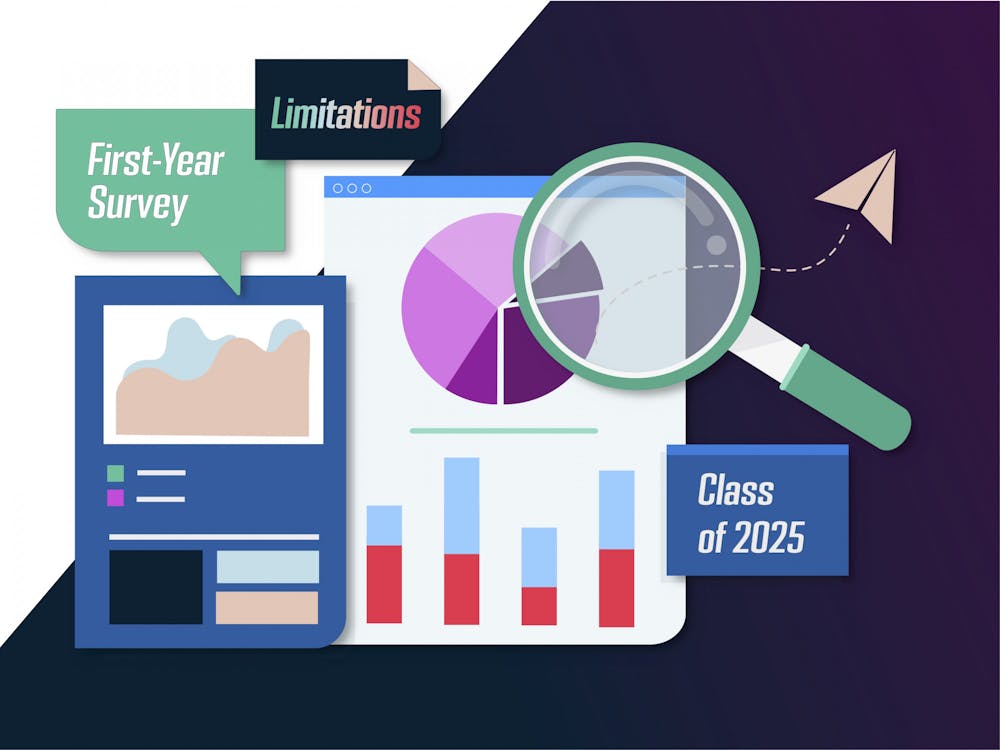Editor's note: This story is part of a series about the Class of 2025 based on a survey conducted by The Chronicle. You can read more about our methodology and limitations here, or see all of our survey coverage here.
This week, The Chronicle will release survey data about the Class of 2025.
For the fifth consecutive year, we surveyed the first-year class about their lifestyles, demographics, plans at Duke and more. Questions ranged from high school test scores and religious beliefs to their approximate family income and campus resource usage.
Many of the questions were similar to last year’s survey. This year, given Duke’s announced shift to a residential housing model, opinions were fielded regarding QuadEx and living learning communities. New questions regarding knowledge and usage of campus resources and amenities were added as well.
Most questions about COVID-19, including whether household members lost their jobs or were furloughed during the pandemic, were removed. Views towards COVID-19 policies and the perceived impact of the pandemic on finding community were still gauged. Questions about the 2020 presidential election were also removed from the survey.
In total, this year’s survey asked 71 questions, compared to 67 questions last year.
The results of this survey will be released throughout the coming week in a series of stories and will give a deeper look at Duke’s newest undergraduate students.
The survey was administered from Oct. 11 to Oct. 27, and 380 first-years filled out 99%-100% complete responses, with 560 total students starting a response. In total, 23.9% of the first-year class completed the survey, and three prizes were randomly awarded to participants.
Professor of Statistical Science Jerry Reiter previously told The Chronicle about the potential limitations of the survey. He said that students’ reasons for opting out of the survey—including lack of access to the survey or low enthusiasm for Duke—could make the results less representative of the class.
Reiter noted that in last year’s survey—which also asked more than 60 questions—students may have not chosen to complete the questionnaire due to time constraints. Reiter wrote in an email that this could result in the nonrespondents being systematically different than the respondents, which could skew the results of the survey.
Below, we compare our survey data with the official Class of 2025 profile from the Office of Undergraduate Admissions. This shows how our survey responses may differ from the overall class.
Race and ethnicity
The Chronicle’s survey gathered race and ethnicity data differently than Duke’s admissions office by including a “race/ethnicity not listed here” category and distinguishing between Native American or Alaskan Native and Native Hawaiian or Pacific Islander students.
Official diversity data records 57% white students; 30% Asian, Asian-American or Pacific Islander students; 11% Black or African American students; 10% Hispanic/Latino/a/x students and 2% Native American, American Indian, Native Alaskan, or Native Hawaiian students. 6% of students did not indicate race.
Of the 380 students The Chronicle surveyed, 39.8% identified as white, 29.2% identified as Asian, 7.1% as Black or African American, 4.2% as Hispanic or Latinx/e and 1.9% as a race/ethnicity not listed. One student identified solely as Native American or Alaska Native.
Students were allowed to select multiple identities, and 67 respondents (17.6%) selected two or more. When this “multiracial” category is disaggregated, 54.2% of respondents identified as white, 36.3% identified as Asian, 13.2% identified as Hispanic or Latinx/e, 10.8% identified as Black, 1.3% identified as Native American or Alaska Native and 0.3% identified as Native Hawaiian or Pacific Islander. About 3% selected a race or ethnicity that was not listed. This largely matches official self-reported race and ethnicity data.
About two-thirds of survey respondents who identified as Hispanic or Latinx/e selected at least one other identity. The majority of those respondents (76.5%) also identified as white, with some respondents saying they also identified as Black, Asian, Native American or Alaska Native.
For consistency of analysis, aggregated data featuring a “multiracial” category was used in our stories. The Chronicle recognizes that this practice eliminates much nuance, but it allows us to compare our results with official data as collected by Duke Admissions in previous years.
Dean of Undergraduate Admissions Christopher Guttentag confirmed in an email to The Chronicle last year that the University’s official racial diversity data did not include an “other” category. The ability for students to identify as more than one race/ethnicity in the official diversity data was newly implemented for the class of 2025.
Geographic and socioeconomic diversity
Get The Chronicle straight to your inbox
Sign up for our weekly newsletter. Cancel at any time.
The New York Times published data about Duke’s socioeconomic diversity based on tax records in 2016. Although there are differences between The Chronicle’s and the Times’ analyses in the metrics used to report the data, our survey data is generally consistent with the Times’ data. The Times’ data shows that the median family income of Duke students is $186,700, and over 50% of students surveyed estimated their household to have an annual household income of $125,000 - $500,000, while 16.1% of students reported an income of $80,000 or less. Just under 15% of respondents reported an annual income greater than $500,000.
The Chronicle’s survey data underrepresents students who receive financial aid. According to Duke data, 50% of the Class of 2025 receive financial aid, compared to 44.4% of our respondents.
Additionally, 10.5% of our respondents—compared to 14% of the Class of 2025—are international students, indicating that our survey underrepresents the percentage of international students and overrepresents the proportion of domestic students.
Academics
The Chronicle’s survey data slightly overrepresents the number of students who attended a public high school and the number that attended a private high school. However, the data is not fully comparable since official data further delineates students who were schooled outside of the United States, which The Chronicle’s survey does not.
Our survey overrepresents the number of students who applied Early Decision. While just under 53% of the class of 2025 was accepted Early Decision, 60% of our respondents were.
The Chronicle’s survey also overrepresents the number of FOCUS students. 30.5% of our respondents are FOCUS participants, while an estimated 20-25% of first-years partake in the program each year, according to the FOCUS website.
The median SAT and ACT scores of survey respondents were 1530 and 35, respectively. Official data places the middle 50% range for SAT and ACT scores at 1510 to 1560 and 34 to 36, respectively.
Other identity groups
Whereas 55% of the Class of 2025 are female-identifying and 45% are male-identifying, 63% of our respondents identified as women and 33.5% identified as men. Just under 3% of students identified as transgender, gender queer/nonbinary, agender or “other.” Under 1% of students chose “prefer not to say.”
Though the Chronicle included more options for gender identity than Duke’s data, the discrepancy indicates that our data overrepresents the number of female-identifying students and underrepresents the number of male-identifying students.
Our survey data slightly underrepresents the number of first-generation college students. Whereas 11% of all first-years are first-generation students, 9.5% of our respondents are.

Ishani Raha is a Pratt junior and a senior editor of The Chronicle's 119th volume.

Nadia Bey, Trinity '23, was managing editor for The Chronicle's 117th volume and digital strategy director for Volume 118.

